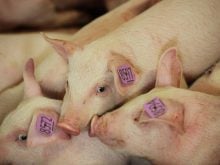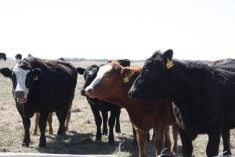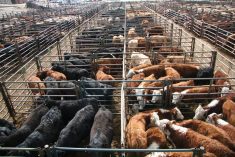RENO, Nev. — The chicken cycle has gone one way for the last 20 years — straight up.
Compared to the highs and lows of the North American cattle cycle, chicken’s popularity among consumers in the United States grows steadily by about five percent a year.
Part of the poultry success story is attributed to clever marketing of a consistent product — something beef lacks, says Topper Thorpe of the American market information service, Cattle-Fax.
The annual market outlook presented at the National Cattlemen’s Association convention said the American cow herd continues to expand even though beef consumption remains flat.
Read Also

Canada told trade crisis solutions in its hands
Canadians and Canadian exporters need to accept that the old rules of trade are over, and open access to the U.S. market may also be over, says the chief financial correspondent for CTV News.
Total cattle inventory as of Jan.1, 1994 is 102.8 million. Annual growth of two to three percent is expected until 1996 when the cow census will hit 105 million.
Rumors of an impending big cull of cows because of an aging female herd are not likely true, said analyst Tom Brink.
A recent survey of Cattle-Fax’s 17 member states showed a more youthful cow herd than previously believed. The reported average is 5.4 years of age.
Income doesn’t always match
This growth in cow numbers doesn’t necessarily translate into higher incomes.
Livestock producers are heading into spring with one of the lowest feed grain inventories in recent memory with a 35-40 day supply.
Long range weather forecasts are for a summer drought in the corn belt making a decent harvest in 1994 dubious. Two years of short grain supplies could drive feed prices sky high, said Cattle-Fax analysts.
“One of the biggest wild cards we face as we look at the market is grain prices,” said Thorpe.
Brink said corn could be in the high $3 per bushel range, which will raise what producers must get in order to break even. But lower prices for their animals compared to last year are also predicted.
Cattle-Fax expects all types of cattle to average less in 1994 than 1993. The Americans may see averages of $73-$74 per hundredweight for Choice fed steers, high $70s for 700-800 lb. Choice feeder steers, and mid-$90s for 400-500 lb. Choice steer calves. Peaks for feeders will occur early in the year, they said.
What to do with the extra beef is the next question facing producers. Consumption continues to decline with 1993 being the worst year to date. The Americans ate 30 kilograms (65.5 lb.) of beef per capita.
What Americans eat
Last year Americans ate 103 kg (228 lb.) of meat in total with an almost even split among beef, pork and chicken, said Cattle-Fax’s Randy Black.
He said if beef producers had upheld consumption of their product, the national herd would be another 17 to 18 million head larger.
Failure to maintain beef’s popularity is partly the fault of cattlemen themselves. Improved quality and consistency in each cut is how beef will save itself, said Thorpe.
The poultry industry knows each piece of chicken will be as good as the last. To compete, the beef industry must find ways to identify which carcass will produce top quality steaks, he said.
“Color and breed is still important in the cattle industry. That doesn’t always mean good eating quality,” said Thorpe.

















